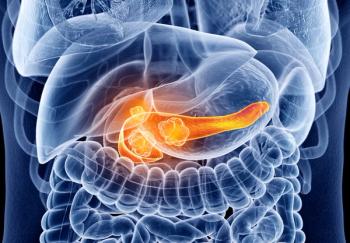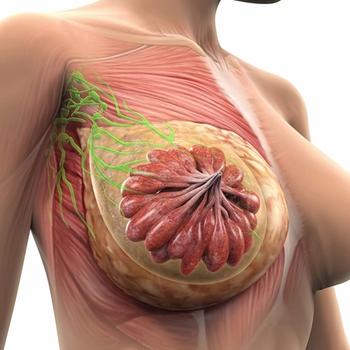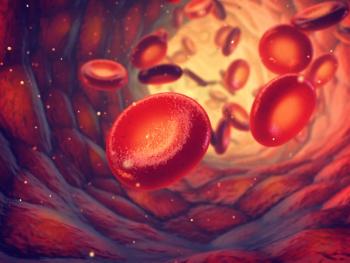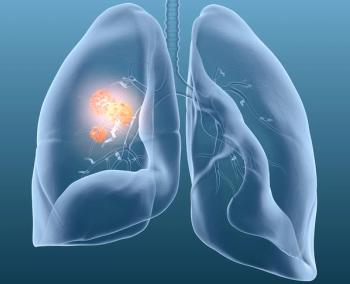
177Lu-Dotatate Improves PFS in Recurrent Meningioma
Efficacy findings were enhanced when 177Lu-Dotatate was used to treat patients with grade II/III recurrent meningioma.
The primary end point of progression-free survival (PFS) was met when 177Lutetium -Dotatate (Lutathera) was used to treat patients with refractory grade II/III meningioma, according to results from a phase 2 trial that was presented at the
The median PFS was 11.5 months, and the 2-year PFS rate was 26.7% (95% CI, 0.12-0.58). The median overall survival (OS) was 27.8 months; the 1-year OS rate was 88.9% (95% CI, 0.76-1.0) and at 2 years, it was 63.8% (95% CI, 0.44-0.92). The best response achieved was stable disease.
“Considering limited alternative therapies, our results support 177Lu-Dotate as a rational therapeutic choice,” Kenneth W. Merrell, MD, a radiation oncologist at the Mayo Clinic Alix School of Medicine, in Rochester, Minnesota, said during the presentation.
Meningioma is the most common brain tumor with 25,000 cases or more annually across the United States, Merrell explained. For WHO grades 2 to 3, the recurrence risk is 40% to 80%, and there is a 2 to 3 times higher mortality risk compared with grade 1. At the time of recurrence, the tumor behavior can often be aggressive. Currently, there are limited options post-surgery and radiation, and systemic therapy remains off-label with no proven efficacy.
Merrell stated that somatostatin receptors (SSTR2) are expressed in 80% to 100% of meningiomas across all grades. Peptide receptor–radionuclide therapy uses a peptide that can be linked to a radionuclide that allows for 177Lu-Dotatate to bind with high affinity to SSTR2. Additionally, 177Lu-Dotatate can be used for specific and targeted radiation for refractory meningioma and has the potential for broad applicability.2
In the Simon 2-stage–designed trial, the study cohort presented at the ASTRO meeting focused on those with WHO grade 2/3. Patients were then registered for the trial and received Ga-Dotatate PET/MR followed by 4 cycles of 177Lu-Dotatate at 8-week intervals. A SPECT/CT dosimetry occurred after the first cycle of 177Lu-Dotatate which was between 23- and 168-hours post-infusion. Active monitoring occurred every 3 years until progression or patients hit 2 years. Event monitoring was done annually.
Twenty patients were enrolled with a median age of 66.8 years old, 35% of patients were female, and 55% had an ECOG performance status of 0. A total 65% of patients had a neuro deficit, 60% had a seizure history, and 15% had received a corticosteroid.
Tumor characteristics included 95% of patients having a World Health Organization (WHO) grade of 2, 55% having a Krenning score of 2 or more, the largest tumor with a 3.5 standard deviation with a 1.8-cm to 7.5-cm range, and all patients previously underwent surgery. Additionally, the median prior courses of radiotherapy were 2, and 15% had prior chemotherapy.
The clinical outcomes benchmark was the Response Assessment in Neuro-Oncology (RANO) which was the systematic review of 47 studies to establish the 6-month PFS (PFS-6) benchmarks for future trial designs. For WHO grades 2 and 3, the PFS-6 rate at benchmark was 26%, less than 30% at a rate not of interest, and 35% or higher rate probably of interest.
Seventy percent of patients overall received 4 infusions. For those with 4 or more cycles, 10% had adverse effects (AEs), 10% had other medical problems, and 10% had progression. There were no AEs that were higher than grade 3 and attributed to 177Lu-Dotatate. The rate of grade 3 non-hematologic AEs was 10%.
Merrell noted that based off these results, 177Lu-Dotate was well tolerated in this population.
“[177Lu-Dotatate] demonstrated clinically meaningful outcomes across a broad patient population, marking a significant milestone for refractory meningioma,” concluded Merrell.
Disclosures: Merrell noted that the study was supported by Novartis.
References
- Merrell KW, Johnson DR, Steinert KO, et al. A prospective phase II study of 177Lu-Dotatate in patients with surgery- and radiation-refractory meningioma: results of the WHO grade II/III cohort. Presented at the 2024 American Society for Radiation Oncology (ASTRO) Annual Meeting; September 30-October 2, 2024; Washington DC. Abstract 2.
- Strosberg J, El-Haddad G, Wolin E, et al. Phase 3 trial of 177Lu-dotatate for midgut neuroendocrine tumors. N Engl J Med. 2017;376(2):125-135. doi:10.1056/NEJMoa1607427
Newsletter
Stay up to date on recent advances in the multidisciplinary approach to cancer.

















































































